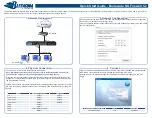
Wirnet iBTS
Document title : Installation and
Maintenance Manual
Version : 2.0
Author : SNI
Date : 04/12/2018
Classification
This document is the strict property of Kerlink and shall not be either copied nor sent without express
written authorization of Kerlink
Internal Use
Kerlink m2m technologies reserved rights
Confidential
Kerlink – 1 rue Jacqueline Auriol – 35235 THORIGNÉ-FOUILLARD
Page 22 / 221
Strict confidential
1.
Description of the Wirnet iBTS
1.1
Modular architecture
The Wirnet iBTS has a modular architecture allowing the operator to configure and upgrade
the gateway to fulfill its needs.
Thanks to the modularity the operator is able to choose:
The backhaul network: Ethernet or GPRS/EDGE/HSPA/CDMA/LTE
The unlicensed band (ISM) where to operate the LoRa LPWAN: 863-873MHz (aka
868MHz), 902-928MHz (aka 915MHz)or 915-928MHz (aka 923MHz)
The number of channels to operate the LoRa LPWAN: 8 to 64
The antenna interface: single (omnidirectional), dual (space diversity or dual
polarization) or tri (sectorization)
Four different modules can be integrated in the Wirnet iBTS:
CPU Module, which includes the main following features:
o
Power management of the Wirnet iBTS
o
CPU
o
Memories
o
GNSS receiver (GPS)
WAN Module, which provides the backhaul functionality:
o
Backup battery
o
4G modem declined in 3 versions depending on the geographical area:
Europe
Americas
APAC
LoRa module – LoRa LOC, which can be also derived in 4 versions :
o
868MHz (863-873MHz)
o
915MHz (902-928MHz)
o
915MHz Full-Duplex (902-915MHz uplink, 923-928MHz downlink)
o
923MHz (915-928MHz)
The Wirnet iBTS can integrate from one to four « LoRa modules ». In this particular “4 LoRa
modules” configuration, a specific “front-end” board and mechanical lid are used to combine
the four “LoRa modules” together (see §1.4.3 for further details).
In its maximum size configuration, the Wirnet iBTS can then integrate six modules: one “CPU
module”, one “WAN module” and four “LoRa modules”.
The Figure 2 below shows an external view of the Wirnet iBTS:
















































